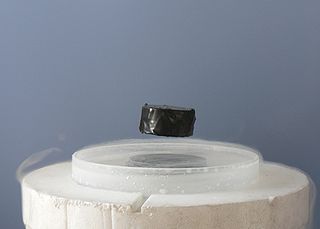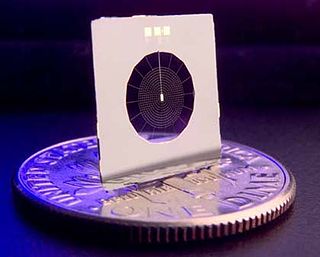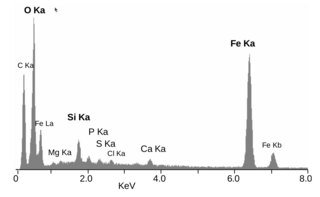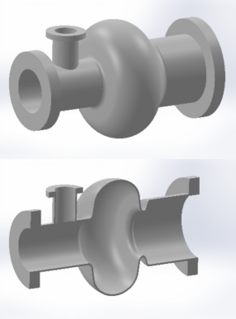Related Research Articles

In physics, cryogenics is the production and behaviour of materials at very low temperatures.

Superconductivity is a set of physical properties observed in certain materials where electrical resistance vanishes and magnetic flux fields are expelled from the material. Any material exhibiting these properties is a superconductor. Unlike an ordinary metallic conductor, whose resistance decreases gradually as its temperature is lowered even down to near absolute zero, a superconductor has a characteristic critical temperature below which the resistance drops abruptly to zero. An electric current through a loop of superconducting wire can persist indefinitely with no power source.

In physics, a state of matter is one of the distinct forms in which matter can exist. Four states of matter are observable in everyday life: solid, liquid, gas, and plasma. Many intermediate states are known to exist, such as liquid crystal, and some states only exist under extreme conditions, such as Bose–Einstein condensates, neutron-degenerate matter, and quark–gluon plasma. For a complete list of all exotic states of matter, see the list of states of matter.

A SQUID is a very sensitive magnetometer used to measure extremely subtle magnetic fields, based on superconducting loops containing Josephson junctions.
Some of the technological applications of superconductivity include:

A bolometer is a device for measuring radiant heat by means of a material having a temperature-dependent electrical resistance. It was invented in 1878 by the American astronomer Samuel Pierpont Langley.

A thermographic camera is a device that creates an image using infrared (IR) radiation, similar to a normal camera that forms an image using visible light. Instead of the 400–700 nanometre (nm) range of the visible light camera, infrared cameras are sensitive to wavelengths from about 1,000 nm to about 14,000 nm (14 μm). The practice of capturing and analyzing the data they provide is called thermography.
In physics, quasiparticles and collective excitations are closely related emergent phenomena arising when a microscopically complicated system such as a solid behaves as if it contained different weakly interacting particles in vacuum.

Energy-dispersive X-ray spectroscopy, sometimes called energy dispersive X-ray analysis or energy dispersive X-ray microanalysis (EDXMA), is an analytical technique used for the elemental analysis or chemical characterization of a sample. It relies on an interaction of some source of X-ray excitation and a sample. Its characterization capabilities are due in large part to the fundamental principle that each element has a unique atomic structure allowing a unique set of peaks on its electromagnetic emission spectrum. The peak positions are predicted by the Moseley's law with accuracy much better than experimental resolution of a typical EDX instrument.

Photodetectors, also called photosensors, are sensors of light or other electromagnetic radiation. There is a wide variety of photodetectors which may be classified by mechanism of detection, such as photoelectric or photochemical effects, or by various performance metrics, such as spectral response. Semiconductor-based photodetectors typically photo detector have a p–n junction that converts light photons into current. The absorbed photons make electron–hole pairs in the depletion region. Photodiodes and photo transistors are a few examples of photo detectors. Solar cells convert some of the light energy absorbed into electrical energy.

Superconducting radio frequency (SRF) science and technology involves the application of electrical superconductors to radio frequency devices. The ultra-low electrical resistivity of a superconducting material allows an RF resonator to obtain an extremely high quality factor, Q. For example, it is commonplace for a 1.3 GHz niobium SRF resonant cavity at 1.8 kelvins to obtain a quality factor of Q=5×1010. Such a very high Q resonator stores energy with very low loss and narrow bandwidth. These properties can be exploited for a variety of applications, including the construction of high-performance particle accelerator structures.
The superconducting tunnel junction (STJ) — also known as a superconductor–insulator–superconductor tunnel junction (SIS) — is an electronic device consisting of two superconductors separated by a very thin layer of insulating material. Current passes through the junction via the process of quantum tunneling. The STJ is a type of Josephson junction, though not all the properties of the STJ are described by the Josephson effect.

A transition-edge sensor (TES) is a type of cryogenic energy sensor or cryogenic particle detector that exploits the strongly temperature-dependent resistance of the superconducting phase transition.

A measuring instrument is a device to measure a physical quantity. In the physical sciences, quality assurance, and engineering, measurement is the activity of obtaining and comparing physical quantities of real-world objects and events. Established standard objects and events are used as units, and the process of measurement gives a number relating the item under study and the referenced unit of measurement. Measuring instruments, and formal test methods which define the instrument's use, are the means by which these relations of numbers are obtained. All measuring instruments are subject to varying degrees of instrument error and measurement uncertainty. These instruments may range from simple objects such as rulers and stopwatches to electron microscopes and particle accelerators. Virtual instrumentation is widely used in the development of modern measuring instruments.

Stefan Janos is a Slovak-Swiss university physicist and professor, founder of very low temperature physics in Slovakia.
Phonon noise, also known as thermal fluctuation noise, arises from the random exchange of energy between a thermal mass and its surrounding environment. This energy is quantized in the form of phonons. Each phonon has an energy of order , where is the Boltzmann constant and is the temperature. The random exchange of energy leads to fluctuations in temperature. This occurs even when the thermal mass and the environment are in thermal equilibrium, i.e. at the same time-average temperature. If a device has a temperature-dependent electrical resistance, then these fluctuations in temperature lead to fluctuations in resistance. Examples of devices where phonon noise is important include bolometers and calorimeters. The superconducting transition edge sensor (TES), which can be operated either as a bolometer or a calorimeter, is an example of a device for which phonon noise can significantly contribute to the total noise.
In electronics, electrothermal feedback is the interaction of the electric current and the temperature in a device with a temperature-dependent electrical resistance. This interaction arises from Joule heating.
Macroscopic quantum phenomena are processes showing quantum behavior at the macroscopic scale, rather than at the atomic scale where quantum effects are prevalent. The best-known examples of macroscopic quantum phenomena are superfluidity and superconductivity; other examples include the quantum Hall effect and topological order. Since 2000 there has been extensive experimental work on quantum gases, particularly Bose–Einstein condensates.

In the field of cryogenics, helium [He] is utilized for a variety of reasons. The combination of helium’s extremely low molecular weight and weak interatomic reactions yield interesting properties when helium is cooled below its critical temperature of 5.2 K to form a liquid. Even at absolute zero (0K), helium does not condense to form a solid under ambient pressure. In this state, the zero point vibrational energies of helium are comparable to very weak interatomic binding interactions, thus preventing lattice formation and giving helium its fluid characteristics. Within this liquid state, helium has two phases referred to as helium I and helium II. Helium I displays thermodynamic and hydrodynamic properties of classical fluids, along with quantum characteristics. However, below its lambda point of 2.17 K, helium transitions to He II and becomes a quantum superfluid with zero viscosity.
References
- Twerenbold, Damian (December 1996). "Cryogenic Particle Detectors". Rep. Prog. Phys. 59 (3): 349–426. Bibcode:1996RPPh...59..349T. doi:10.1088/0034-4885/59/3/002. S2CID 250872972.
- Enss, Christian, ed. (2005). Cryogenic Particle Detection. Springer, Topics in applied physics 99. ISBN 978-3-540-20113-7.
- ^ Glass, I. S. (1999). Handbook of Infrared Astronomy. New York: Cambridge University Press. ISBN 978-0-521-63311-6.
- ^ Primack, J. R.; D. Seckel; B. Sadoulet (December 1988). "Detection of Cosmic Dark Matter". Annual Review of Nuclear and Particle Science . 38 (38): 751–807. Bibcode:1988ARNPS..38..751P. doi: 10.1146/annurev.ns.38.120188.003535 .
- ^ Pretzl, K. (1988). "Dark Matter Searches" (PDF). Space Science Reviews. 130 (1–4): 63–72. Bibcode:2007SSRv..130...63P. doi:10.1007/s11214-007-9151-0. S2CID 59043993.
- ^ Semenov, A. D.; Gol’Tsman, Gregory N.; Korneev, Alexander A. (2001). "Quantum detection by current carrying superconducting film". Physica C. 351 (4): 349–356. Bibcode:2001PhyC..351..349S. doi:10.1016/S0921-4534(00)01637-3.
- ^ Gol'tsman, G. N.; Okunev, O.; Chulkova, G.; Lipatov, A.; Semenov, A.; Smirnov, K.; Voronov, B.; Dzardanov, A.; et al. (2001). "Picosecond superconducting single-photon optical detector". Applied Physics Letters. 79 (6): 705–707. Bibcode:2001ApPhL..79..705G. doi:10.1063/1.1388868.